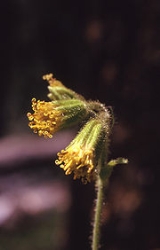
Arnica parryi
Encyclopedia
Arnica parryi is a species of arnica
known by the common name Parry's arnica. It is native to western North America from Yukon
to California
to Colorado
, where it is a resident of temperate coniferous forests.
This is a rhizomatous
perennial herb producing a single unbranched stem to heights between 10 and 60 centimeters. There are oval-shaped leaves around the base of the stem and a few pairs of longer, narrower petioled
leaves above them. The leaves may approach 20 centimeters in length on larger individuals.
The inflorescence
holds one to several daisylike flower heads
, which nod as buds and then pull erect when the face opens. Each head has a center filled with yellow disc florets and usually several yellow ray florets around the edge. The fruit is a cylindrical achene
about half a centimeter long with a bristly pappus
.
Arnica
Arnica is a genus with about 30 perennial, herbaceous species, belonging to the sunflower family . The genus name Arnica may be derived from the Greek arna, "lamb", in reference to the soft, hairy leaves....
known by the common name Parry's arnica. It is native to western North America from Yukon
Yukon
Yukon is the westernmost and smallest of Canada's three federal territories. It was named after the Yukon River. The word Yukon means "Great River" in Gwich’in....
to California
California
California is a state located on the West Coast of the United States. It is by far the most populous U.S. state, and the third-largest by land area...
to Colorado
Colorado
Colorado is a U.S. state that encompasses much of the Rocky Mountains as well as the northeastern portion of the Colorado Plateau and the western edge of the Great Plains...
, where it is a resident of temperate coniferous forests.
This is a rhizomatous
Rhizome
In botany and dendrology, a rhizome is a characteristically horizontal stem of a plant that is usually found underground, often sending out roots and shoots from its nodes...
perennial herb producing a single unbranched stem to heights between 10 and 60 centimeters. There are oval-shaped leaves around the base of the stem and a few pairs of longer, narrower petioled
Petiole (botany)
In botany, the petiole is the stalk attaching the leaf blade to the stem. The petiole usually has the same internal structure as the stem. Outgrowths appearing on each side of the petiole are called stipules. Leaves lacking a petiole are called sessile, or clasping when they partly surround the...
leaves above them. The leaves may approach 20 centimeters in length on larger individuals.
The inflorescence
Inflorescence
An inflorescence is a group or cluster of flowers arranged on a stem that is composed of a main branch or a complicated arrangement of branches. Strictly, it is the part of the shoot of seed plants where flowers are formed and which is accordingly modified...
holds one to several daisylike flower heads
Head (botany)
The capitulum is considered the most derived form of inflorescence. Flower heads found outside Asteraceae show lesser degrees of specialization....
, which nod as buds and then pull erect when the face opens. Each head has a center filled with yellow disc florets and usually several yellow ray florets around the edge. The fruit is a cylindrical achene
Achene
An achene is a type of simple dry fruit produced by many species of flowering plants. Achenes are monocarpellate and indehiscent...
about half a centimeter long with a bristly pappus
Pappus (flower structure)
The pappus is the modified calyx, the part of an individual disk, ray or ligule floret surrounding the base of the corolla, in flower heads of the plant family Asteraceae. The pappus may be composed of bristles , awns, scales, or may be absent. In some species, the pappus is too small to see...
.

